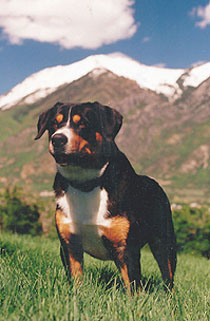
|

|

The earliest of the Estrela's ancestors were herd-guarding dogs in the Serra de Estrela, in what is now Portugal. Since
there are no written records, it is not known for sure whether they were brought by the Romans when they colonized the Iberian
Peninsula, or later by the invading Visigoths. Regardless, there is no disagreement that the Estrela is one of the oldest
breeds in Portugal.
Those early guardian dogs were not the distinct breed we know today. Rather, the Estrela developed
over a period of hundreds of years. Shepherds would have chosen to breed the dogs that had the characteristics necessary to
survive in their mountain environment and to do their job: large size, strength, endurance, agility, a deep chest, ability
to tolerate a marginal diet, the set of the legs, a powerful mouth, a tuft of hair around the neck, an easy, jog-like gait,
a warm coat, and a watchful, mistrustful, yet loyal temperament. Since the region was isolated, there was little breeding
with non-native dogs, leading to the purity of the breed.
Life changed little for the people and dogs of the region,
even into the 20th century. The isolation of the region meant the breed was relatively unknown outside it until the early
1900's, and even then, they were mostly ignored in early dog shows. The Portuguese admired foreign breeds much more than their
own. Shepherds often castrated their dogs to prevent them from leaving their flocks to mate. These factors were having a negative
effect on the Estrela. So from 1908 to 1919, special shows called concursos were held to promote and preserve the Estrela
breed in the region. During this period there was some attempt at a registry (of which there is no surviving record). Special
livestock guardian working trials were included in these shows. The trial consisted of an owner bringing his dog into a large
field with many flocks of sheep. The dog was observed by judges for its reactions coming into the field and as the shepherd
was ordered to move the flock, which inevitably produced stragglers. The dog was expected to move from his spot of guarding
to bring the stragglers back, and then assume a leadership position at the head of the flock.
The first, tentative,
recorded breed standard was published in 1922. This standard just reflected the functional features naturally found in the
best dogs of the time, although it did mention the dew claws as reflecting a "perfect" dog. The hooked tail and the turned-back
ears, which later became part of the official standard, were not mentioned.
The first official breed standard was written
in 1933. This standard attempted to differentiate the Estrela as a distinct breed. This led to the hooked tail and double
dew claws becoming a requirement. All colors were allowed. The standard has undergone small refinements since then. For example,
dew claws became optional by 1955, and the allowed colors have been limited a few times to achieve today's current set.
Prior
to World War II, the Estrela's breeders were still primarily the shepherds and farmers of the region. Since they were mostly
illiterate, they did not make any attempt to follow the official breed standard, if they even knew one existed. But by the
early 1950's, interest in the breed returned, and the annual concursos were reinstated. Again the intent was to stimulate
interest among the Serra residents and to encourage them to adhere to the official standard. During this period, the long-haired
variety was most popular at shows, but "show dogs" represented (and still do) only a small portion of the Estrela population
in Portugal. Many of the working dogs were (and are) short-haired.
Early in the 1970's, interest was steeply declining.
There was some concern about the degeneration and even possible extinction of the breed. But the Portuguese revolution of
1974 helped save the Estrela. It led to changes both in dog shows in Portugal and in Portuguese dog breeds. Prior to the revolution,
dog showing had largely been a pastime of the wealthy, with their preference for non-Portuguese breeds as status symbols.
Now, working people could and did show the native dogs they preferred. Also, with the revolution came an increase in crime
and thus more interest in guard dogs.
There is no record of Estrelas outside Portugal prior to 1972. While some undoubtedly
did leave the country, they were probably interbred with no effort to maintain the breed. In 1972 and 1973, pairs were imported
to the US. Others were probably imported into the US since then, but it was not until 1998 that the first EMDAA-recognized
dog was brought over to the US. The United Kingdom was the first country to establish the breed outside Portugal in 1972.
Today the Estrela can be found in many countries.
To this day, the Estrela Mountain Dog remains true to its guardian
heritage. It is still a working dog, guarding flocks in its native Portugal and elsewhere. The Portuguese use it as a police
dog. It is also an ideal family pet because of its alertness, loyalty, intelligence, and its instinct to nurture young, all
features it needed in its earliest days.
|

|

|

